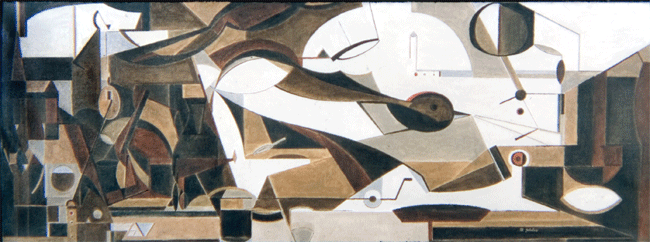An Interview With Maurice Golubov
This interview is a part of the ‘Maurice Golubov – Catalog from a multi-museum traveling exhibition organized by the Mint Museum’
Symbolism in art means the objectification of the subjective, or the portrayal of dreams in such a way that they seem real and tangible. Realism and Impressionism, on the other hand, stress a subjective interpretation of the external world (Zola’s “Nature seen through a temperament”). Maurice Golubov’s art hovers somewhere between these two extremes, which, perhaps, are not so very opposite after all.
Golubov’s world is at once spiritual, intensely personal, yet often based on the city, New York City. He has always carried his own world within him, but at the same time maintained his affiliation with the external world. As a child of six in Russia, he found a Bible illustrated by Doré which transported him, and which he copied. From his young adulthood in New York City, and throughout a lifetime, he worked for commercial art firms. Now 75, he lives near Miami, in an area where most people his age have retired. Surrounded by palm trees, swimming pools, golf courses, he could just as easily be in Siberia — or New York City. He paints today with unabated energies; if anything, his pace has quickened. His inner time clock has mysteriously synchronized with a rapider world, and his art reflects the fast pulse and sharp fragmentation of the atomic age.
Shattered, straighter particles today replace the dreamer, sensual calmer curves of a slower world of the ’20’s and ’30’s.
An art historian and immediately thinks of parallels. Redon, Klee, Tobey come to mind, but his art isn’t like any of theirs. His paintings jump unashamedly and unselfconsciously from subject to subject, style to style, even from representation to abstraction. Golubov has suffered the inevitable fate of an artist whom one cannot pigeonhole. Not categorizable, he has instead been omitted. He preferred earning his living by means of commercial illustration to compromising his vision in order to sell to galleries. Although he despised this work on the one hand, he is quick to recognize its importance for facilitating his technical precision.
Golubov, dreamer, mystic, philosopher, but pragmatist (like Gustave Moreau, who was once described as a hermit who knew the train schedule), is certainly accustomed to the unexpected and the inexplicable. Jewish mysticism provided much inspiration for him from an early age despite the Jewish religion’s ban on pictorial representation of figures. Punished by his mother for copying Doré, he sought symbolic equivalents for ideas which inspired him. Separated from his family at the age of twelve, he made his own way to Petrograd, miraculously rejoining them and travelling to New York. There he stumbled into a class at a Jewish community center taught by John Sloan. Today, though primarily an abstract painter, he acknowledges receiving great inspiration from Sloan, as well as from a number of academic painters under whom he subsequently studied at the National Academy of Design. The only other artistic influences he admits are the old masters — Titian, Rembrandt and Rubens — and Cezanne.
A man impassioned by music, literature, an “infinite” world which can never be circumscribed, but only suggested, Golubov almost seems like a present-day Redon, and yet his work — that of a Russian Jew who immigrated to New York as a child — looks entirely different. He always resisted following prevailing movements and styles. At a time when figurative painting was out of fashion, he persisted in painting both figures and so-called “abstraction”. The figures and visually accurate landscapes sometimes appear expressionistic, at opposite extremes from the visionary, controlled, geometrically-based mindscapes. He paradoxically, however uses structure and mathematics to strive towards the infinite; like music, to suggest freedom.
How does he reconcile his figurative and his abstract worlds? In a way, he doesn’t. He insists that he must never compromise. He always sets out to do one or the other, though he sometimes uses abstract forms to underlie representation. He knew all the bright lights of the art world during its most exciting phases in New York, but remained essentially alone in their midst. Unlike the abstract expressionists, Golubov never appears to have undergone a crisis of subject matter. Content has always flowed into his head — as it continues to do — at such a rapid rate that he has difficulty keeping up with it physically. His only regret now seems to be that he does not have enough physical energy to carry out all his ideas, wishing he had some talented students who could further his explorations.
For Golubov, the everyday, perceived world is easier to paint than the symbols in his mind. He uses representation as a respite from the complexities and rigors of what he considers to be the real world — a kind of Platonic mind-set, an enduring universe of symbols underlying the fluctuating, transitory images of the everyday.
The following interview took place in December, 1979, in Golubov’s Hollywood, Florida apartment. A testament to his indifference to his surroundings, his apartment is loaded with paintings in various stages of development. The most recent painting on his easel as we talked was large, abstract and based on Hebrew letters, telling the beginning of Genesis. He has returned (though perhaps he has never departed) to his early love for Jewish mystical literature. As we spoke, he was particularly delighted to know that some of his paintings were hanging in the Metropolitan Museum of Art, in the room next to those of his beloved Titian.
